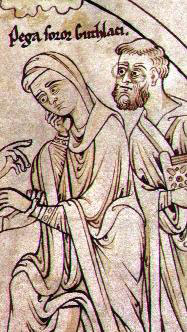
Feastday: January 8
Birth: 673
Death: 719
Pega was sister to St. Guthlac and she lived a retired life not far from her brother's hermitage at Croyland, just across the border of what is now Northamptonshire, on the western edge of the great Peterborough Fen. The place is not called Peakirk, i.e. Pega's church. She attended her brother's funeral, making the journey by water down the Welland, and is reputed on that occasion to have cured a blind man from Wisbech. She is said to have then gone on pilgrimage to Rome, where she died about the year 719. Ordericus Vitalis says her relics were honored with miracles, and kept in a church which bore her name at Rome, but this church is not now known.
8th-century Anglo-Saxon anchoress and saint This article is about the Christian saint. For the software, see Pegasystems.
Pega (c. 673 – c. 719) is a Christian saint who was an anchoress in the ancient Anglo-Saxon kingdom of Mercia, and the sister of Saint Guthlac.
Life
 The parish church in Peakirk is dedicated to Saint Pega
The parish church in Peakirk is dedicated to Saint Pega
The earliest source of information about Pega is in Felix's 8th-century Latin Life of Guthlac, where she is referred to as 'the holy virgin of Christ Pega'. As the sister of Guthlac, Pega would have been the daughter of Penwalh of Mercia and thus belonged to one of Mercia's great noble families.
She lived as an anchoress at what is now Peakirk ("Pega's church") near Peterborough, not far from Guthlac's hermitage at Crowland. When Guthlac realised that his end was near in 714, he summoned Pega, who travelled by boat to her brother's oratory to bury him. One year later, she presided over the translation of his remains into a new sepulchre, when his body was found to be incorrupt. At this time, Pega also used a piece of glutinous salt, which had been previously consecrated by Guthlac, to cure the eyesight of a blind man who had travelled to Crowland from Wisbech.
Henry of Avranches, in his 13th-century poetic life of Guthlac, adds the detail that Guthlac banished Pega from Crowland after the devil assumed her appearance and tempted him to break his fast.
In the 15th-century Croyland Chronicle, Pseudo-Ingulf claims that Pega inherited Guthlac's psalter and scourge, both of which she later gave to Kenulph, the first abbot of Crowland Abbey.
Death, miracles and legacy
Pega went on pilgrimage to Rome after Guthlac's death and died there on 8 January 719, according to a 12th-century account by Orderic Vitalis. Orderic claims that her remains were kept at a church built in Rome in her honour, and that miracles took place there.
The precise location of Pega's hermitage is not known, but it is possible that it was on the site of the 14th-century 'Hermitage Chapel' in Peakirk, which is now a private residence.
Peakirk's parish church is uniquely dedicated to Pega. There is a local legend that Pega's heart was returned to Peakirk and was kept as a relic in the church contained in a heart stone. Its broken remains can still be seen in the south aisle window.





